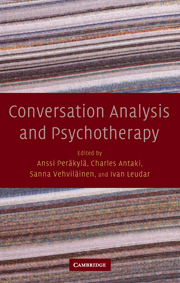Book contents
- Frontmatter
- Contents
- List of illustrations
- List of contributors
- Foreword: Filling the gaps
- 1 Analysing psychotherapy in practice
- 2 Formulations in psychotherapy
- 3 Clients' responses to therapists' reinterpretations
- 4 Lexical substitution as a therapeutic resource
- 5 Resisting optimistic questions in narrative and solution-focused therapies
- 6 Conversation analysis and psychoanalysis: Interpretation, affect, and intersubjectivity
- 7 Identifying and managing resistance in psychoanalytic interaction
- 8 Person reference as a device for constructing experiences as typical in group therapy
- 9 Conversation of emotions: On turning play into psychoanalytic psychotherapy
- 10 A psychotherapist's view of conversation analysis
- 11 A review of conversational practices in psychotherapy
- Transcription notation
- References
- Author index
- Subject index
9 - Conversation of emotions: On turning play into psychoanalytic psychotherapy
Published online by Cambridge University Press: 22 September 2009
- Frontmatter
- Contents
- List of illustrations
- List of contributors
- Foreword: Filling the gaps
- 1 Analysing psychotherapy in practice
- 2 Formulations in psychotherapy
- 3 Clients' responses to therapists' reinterpretations
- 4 Lexical substitution as a therapeutic resource
- 5 Resisting optimistic questions in narrative and solution-focused therapies
- 6 Conversation analysis and psychoanalysis: Interpretation, affect, and intersubjectivity
- 7 Identifying and managing resistance in psychoanalytic interaction
- 8 Person reference as a device for constructing experiences as typical in group therapy
- 9 Conversation of emotions: On turning play into psychoanalytic psychotherapy
- 10 A psychotherapist's view of conversation analysis
- 11 A review of conversational practices in psychotherapy
- Transcription notation
- References
- Author index
- Subject index
Summary
This chapter is a collaboration between academic researchers and psychoanalytic child psychotherapists working in an economically deprived part of a large city in England. We explore the ways in which the psychotherapists' training and experience – what we refer to as their “therapeutic orientation” – are made relevant and consequential in their therapeutic interactions. We argue that such therapeutic orientation needs to be taken on board by analysts of interaction if they are to grasp the relevant sense of therapeutic activities carried out in and through talk.
The chapter presents an ethnomethodological case study. We examine four consecutive group psychoanalytic psychotherapy sessions – how they unfold and how children come to use what the situations afford. Alongside the audiovisual recordings, we scrutinize the therapists' own write-ups of the sessions, which were produced after the event by the trainee sitting in on the sessions. These write-ups display the therapists' professional orientation to the activities in sessions and consequently enable understanding of the interactions in terms of the “schooled experience” of the therapists. Moreover, in preparing this chapter, the “first pass analyses” of the video recordings have been discussed with the authors who acted as therapists. These discussions pinpointed misunderstandings, omissions, and errors, and made it possible to correct and extend the initial analysis and highlight the real differences of opinion among the authors as to what may be happening.
- Type
- Chapter
- Information
- Conversation Analysis and Psychotherapy , pp. 152 - 172Publisher: Cambridge University PressPrint publication year: 2008
- 12
- Cited by



